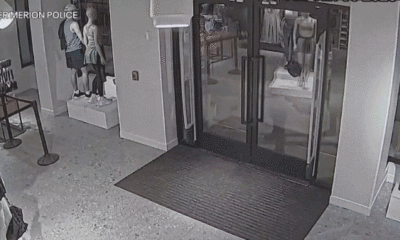Pennsylvania
Here’s some of what’s in the bill that directs historic new Pa. education funding • Pennsylvania Capital-Star

Perhaps the most significant number in the 2025 budget is $1.1 billion in new spending on K-12 education.
The funding comes after Commonwealth Court declared that Pennsylvania’s current method of funding public schools was unconstitutional, citing inequities between the state’s wealthiest school districts and its poorest.
While the general appropriations bill — the legislative centerpiece of the budget — outlines how much money will go towards education in the coming year, it’s another bill that tells the state how it can spend those funds: the public school code bill.
Code bills are passed alongside the budget. While the general appropriations bill says how much money each part of the government will get, the code bills more or less lay out how those dollars can be spent.
The bill also contains what are effectively individual policies, from the massive new funding formula that will change how money is distributed to Pennsylvania’s school districts, to smaller policy points, like allowing schools grants to provide menstrual hygiene products.
Here are some of the big items that made it into this year’s code bill:
The new funding formula
Arguably the most substantive part of the bill lays out how more than $526 million in adequacy and equity grants will be distributed to Pennsylvania’s school districts based on factors like the student poverty rate.
Because schools receive so much funding from property taxes, school districts where property values are lower have an inherent disadvantage.
The $526 million in new funds is intended to shrink that equity gap, and award extra money to schools with high levels of poverty among its students and greater numbers of kids whose primary language isn’t English.
What data would drive those funds was one of the biggest sources of contention between Democrats and Republicans during the drawn-out budget negotiations.
Democrats had hoped to use data reported by the school districts themselves, while Republicans wanted to use U.S. Census data.
Rep. Mike Sturla (D-Lancaster), who was a leader in creating the House Democrats’ version of a funding formula, said, “the schools have a pretty good idea when they’re talking to these parents whether or not they’re making $30,000 a year or they’re making $300,000.”
He said that census data has historically underreported poverty.
However, Senate Republicans, who ultimately won out, said that the self-reported data is too hard to verify.
Ultimately, the parties agreed to use census figures.
Democrats had to make other concessions in the fight over equity funding as well. Back in February, Gov. Josh Shapiro had proposed spending $872 million on closing the equity gap, a number that was rejected by Republicans.
Charter school restraints
When a student attends a charter school, the charter school gets money that would have gone to the student’s school district. The amount is based on the average per-student spending of that school district, with a separate formula for students with disabilities..
The code bill establishes a formula for reimbursing traditional public schools for some of the money that follows would-be students to cyber charter schools. The budget set aside $100 million for that purpose. It also changes the formula for how much money follows students with special needs, which is estimated to save public schools $34.5 million.
The bill would also force charter schools to put in their advertisements that they were paid for with taxpayer dollars, a largely symbolic victory for Democrats who opposed money intended for public schools going to charters.
It also makes new requirements of charter school board members. At least five must be non related voting members. Charter schools will also be required to make certain budget documents public.
Security and mental health grants
Schools will receive $120 million to provide security and mental health services. Every school will now be required to have a security guard, and the money can go to funding that position. Plus, those security guards can be armed.
Of that, $20 million is set aside for safety grants for non-public schools and school entities like charters.
Odds and ends
The bill also provides funding for policies that had been included in bills that were introduced through the traditional legislative process, but never completed by the House or Senate.
That includes up to $3 million for grants that would allow schools to purchase feminine hygiene products. The idea appears similar to one proposed in a House bill sponsored by Rep. Darisha Parker (D-Philadelphia).
Rep. Stephanie Borowicz (R-Clinton) said the free tampons could promote “communism” when the bill was debated on the House floor. The bill was never taken up in the Republican-controlled Senate.
Funding for a grant program that would allow schools to lock students’ cell phones away during the school day mirrors a bill sponsored by Sen. Ryan Aument (R-Lancaster). That bill passed the Senate, but never appeared in the House.
The public school code bill would allow some of the school safety and mental health funding to go towards the purchase of special bags that can be locked during the day for students to place their phones in — so long as the school comes up with a policy prohibiting cell phone use during the school day.

Pennsylvania
Pennsylvania Gov. Shapiro has $30 million for his reelection bid, a new state record

Pennsylvania
3 winning scratch-off lotto tickets totaling $7.5M sold in Pennsylvania

RADNOR TWP., Pa. (WPVI) — Three winning scratch-off tickets totaling $7.5 million were sold in Pennsylvania, lottery officials announced on Monday.
One winning “MONOPOLY Own It All” ticket worth $5 million was sold in Delaware County at the GIANT on the 500 block of East Lancaster Avenue. The grocery store will receive a $10,000 bonus for selling the winning ticket.
“MONOPOLY Own It All” is a $50 game that offers top prizes of $5 million.
In Erie County, a $1.5 million-winning “Cash Spectacular” scratch-off was purchased at a Sheetz on Perry Highway. “Cash Spectacular” is a $30 game that offers top prizes of $1.5 million.
And in Luzerne County, a $1 million-winning “Millionaire Loading” scratch-off was sold at Schiel’s Family Market in Wilkes-Barre. “Millionaire Loading” is a $20 game that offers top prizes of $1 million.
Scratch-off prizes expire one year from the game’s end-sale date posted at palottery.com.
Winners should immediately sign the back of their ticket and call the Pennsylvania Lottery at 1-800-692-7481.
Copyright © 2026 WPVI-TV. All Rights Reserved.
Pennsylvania
Where did people move to in 2025? Here’s what U-Haul says and how Pennsylvania ranks

Are Trump’s signature tariffs even legal?
Rising health care costs, limits on executive power and two ongoing conflicts are all substantive issues Trump faces in the new year as midterms near.
A new report from U-Haul shows where Pennsylvania residents are leaving to and where new residents are coming from in 2025. Here’s what to know about U-Haul’s top 10 states with the most and least growth numbers.
Eight warm weather states made U-Haul’s top 10 growth list for 2025, while eight states in the colder Northeast and Midwest filled out the bottom 10, including Pennsylvania and neighboring New York, New Jersey, and Ohio. Delaware ranked 21 out of 50 states in growth for 2025.
U-Haul also noted besides geography, that seven of the 10 states with the most growth featured Republican governors, nine of which went red in the last presidential election, and 9 out of 10 in the bottom growth states featured Democrat governors, seven of which went blue in the last presidential election.
“We continue to find that life circumstances — marriage, children, a death in the family, college, jobs and other events — dictate the need for most moves,” said John “J.T.” Taylor, U-Haul International president in press release. Adding, “But other factors can be important to people who are looking to change their surroundings. In-migration states are often appealing to those customers.”
U-Haul ranks states growth based on their one-way customer transactions that rented trucks, trailers or moving containers in one state and dropped it off in another state. Their growth index included over 2.5 million annual one-way transactions across the United States and Canada.
Texas holds the number one U-Haul growth state for the seventh time in the last 10 years while California ranked last for the sixth year in a how.
Pennsylvania’s growth rank for 2025 remained at a low 46 out of 50 states, same as 2024, and compared relatively similar to its growth numbers over the last 10 years, according to U-Haul’s data, with the exception during 2022-2023 when its highest growth numbers hit 24 out of 50 in 2022 and 38 out of 50 in 2023.
Oregon, Mississippi, Colorado, Nevada, New Mexico, Louisiana and Montana were among the biggest year-over-year gainers in 2025 compared to U-Haul’s 2024 rankings, while Ohio, Virginia, Indiana, Iowa, Delaware and Nebraska saw the biggest drops.
While the national average rent in the U.S. sits at approximately $1,623 per month (0.4% higher than this time last year) the Keystone State boasts a lower rent average at approximately $1,526 per month (1.9% higher than last year), according to Apartments.com. It is ranked 34th least expensive rent by state.
Here’s what to know about Pennsylvania and what states saw the most and least growth in 2025 according to U-Haul.
Top 10 U-Haul growth states of 2025
In 2025 Pennsylvania ranked 46 out of 50 states on growth as reported by U-Haul.
- Texas
- Florida
- North Carolina
- Tennessee
- South Carolina
- Washington
- Arizona
- Idaho
- Alabama
- Georgia
U-Haul reported the 10 states with the lowest growth numbers were lead by California, Illinois, New Jersey, New York, Massachusetts, Maryland, Pennsylvania, Ohio, Connecticut, and Michigan.
Where are Pennsylvania residents moving to and from?
According to the company’s semiannual U.S. migration trends report, based on the one-way rental data after the summer’s high moving season, it revealed that while Pennsylvania remains a top destination, Pennsylvanians are also packing up and heading out. Here’s where they moved to:
- New York
- Maryland
- North Carolina
- Massachusettes
- Ohio
- Michigan
- Florida
- California
- Washington D.C.
According to this report, here’s what states new residents came from:
- New Jersey
- New York
- Maryland
- Florida
- Virginia
- North Carolina
- Delaware
- Massachusetts
- Ohio
- Texas
- West Virginia
- Michigan
-

 World1 week ago
World1 week agoHamas builds new terror regime in Gaza, recruiting teens amid problematic election
-

 News1 week ago
News1 week agoFor those who help the poor, 2025 goes down as a year of chaos
-

 Business1 week ago
Business1 week agoInstacart ends AI pricing test that charged shoppers different prices for the same items
-

 Health1 week ago
Health1 week agoDid holiday stress wreak havoc on your gut? Doctors say 6 simple tips can help
-

 Technology1 week ago
Technology1 week agoChatGPT’s GPT-5.2 is here, and it feels rushed
-

 Business1 week ago
Business1 week agoA tale of two Ralphs — Lauren and the supermarket — shows the reality of a K-shaped economy
-

 Science1 week ago
Science1 week agoWe Asked for Environmental Fixes in Your State. You Sent In Thousands.
-

 Politics1 week ago
Politics1 week agoThe biggest losers of 2025: Who fell flat as the year closed























